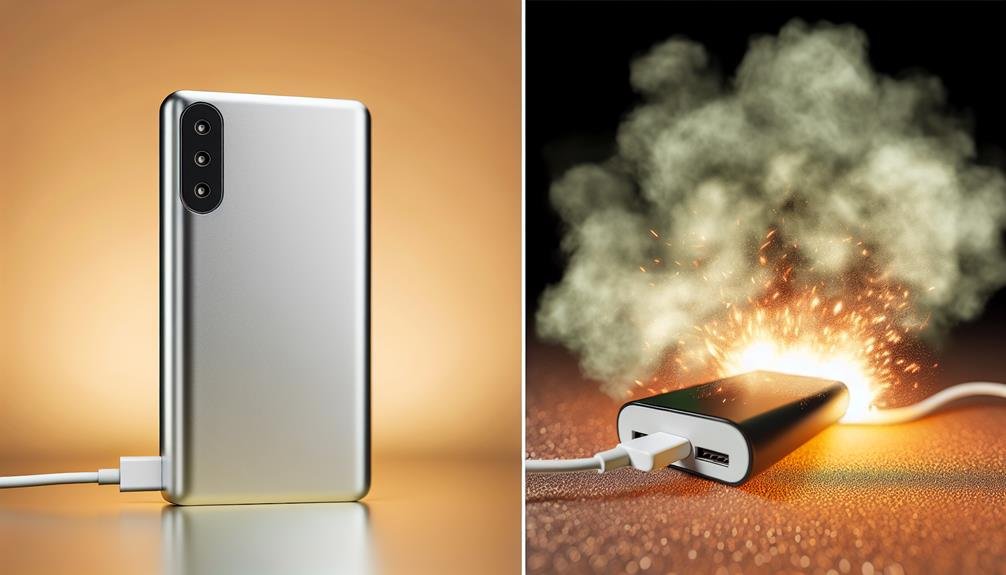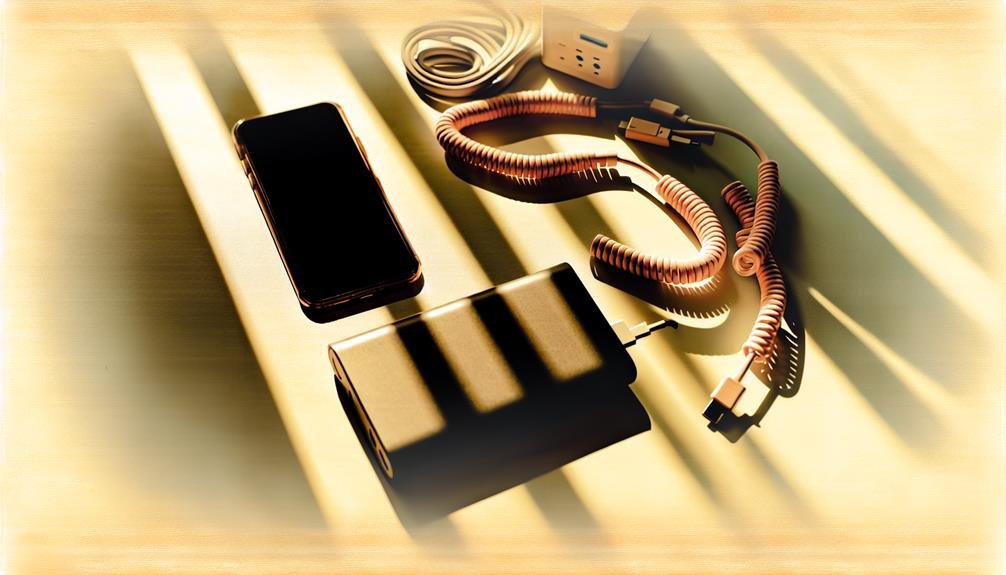Yes, a power bank can damage your phone battery if it's of low quality or not appropriately matched to your device's specifications. Using unregulated power can lead to overcharging, overheating, and fluctuating voltage, all of which harm battery health. High-quality power banks with proper voltage regulation, overcharge protection, and certified components can prevent these issues. Confirm the power bank's capacity aligns with your phone's battery needs to avoid overloading. Additionally, features like automatic shutoff can greatly enhance safety and efficiency. Understanding the nuances of power banks will help you make a more informed decision and protect your device.
Understanding Power Banks

To truly understand how power banks might harm your phone battery, it is crucial to first comprehend the technical workings and specifications of these portable chargers. At their core, power banks are essentially external batteries designed to furnish your device with power on-the-go. They come in various capacities, measured in milliampere-hours (mAh), which indicate how much charge they can hold and subsequently transfer to your phone.
When it comes to battery maintenance, not all power banks are created equal. Poor quality power banks might lack necessary features like overcharge protection, which can lead to excessive charging cycles. Consistently overcharging your phone can degrade its battery life over time. Additionally, the charging rate, measured in amperes (A), needs to be compatible with your device's specifications. Using a power bank with a higher or lower charging rate than what your phone supports can result in inefficient charging or even damage.
Device compatibility is another crucial factor. It is vital that the power bank's output voltage matches your phone's requirements. Mismatched voltages can cause overheating, reduced battery efficiency, or even permanent damage. By understanding these technical aspects, you'll be better prepared to select a safe and efficient power bank for your device.
How Power Banks Work
You need to understand that power banks store electrical energy in their internal batteries and then transfer it to your phone via a USB connection. Their capacity, measured in milliampere-hours (mAh), determines how many times they can charge your device. When evaluating a power bank, consider not only its capacity but also the efficiency of its charging mechanism, as this impacts the phone battery's health.
Charging Mechanism Explained
Understanding how power banks operate involves dissecting their charging mechanisms and the technology that guarantees efficient energy transfer to your devices. At the core, power banks utilize lithium-ion or lithium-polymer batteries, designed to store and discharge energy effectively. When you connect your phone to a power bank, it initiates a transfer of energy through a regulated output voltage, typically 5V for USB interfaces.
Crucially, power banks are equipped with sophisticated circuitry to manage battery health and charging cycles. These circuits control the charging current to prevent overcharging risks, thereby safeguarding your phone's battery longevity. Overcharging can lead to excessive heat build-up, causing potential damage and reducing the lifespan of your phone's battery.
Modern power banks often include features such as automatic shutoff and trickle charging to mitigate these risks. Automatic shutoff halts the energy flow once your device reaches full charge, while trickle charging supplies just enough power to maintain your battery at 100% without stressing it. By maintaining these safeguards, power banks guarantee a balanced charging process, promoting battery health and extending the overall life of both the power bank and your device.
Power Bank Capacity
A power bank's capacity, measured in milliamp-hours (mAh), determines how much charge it can store and subsequently provide to your devices. Understanding this capacity is essential for maintaining battery longevity and establishing safe charging habits.
When selecting a power bank, confirm its mAh rating aligns with your device models. Matching the power bank's capacity to your device's battery size will help avoid overcharging, which can degrade battery health over time. Here's a quick reference table:
| Power Bank Capacity (mAh) | Suitable Device Models |
|---|---|
| 5,000 – 10,000 | Smartphones, Small Tablets |
| 10,000 – 20,000 | Tablets, Multiple Smartphones |
| 20,000+ | Laptops, High-Capacity Devices |
Power bank compatibility is another vital factor. Different device models have varying power requirements, and using an incompatible power bank can lead to inefficient charging or, worse, potential damage. Always check whether the power bank supports the voltage and current specifications of your devices.
Lastly, your charging habits play a significant role. Avoid using a power bank with a notably higher capacity than needed, as this can lead to overcharging and heat buildup, both harmful to battery longevity. Prioritize safety by choosing a power bank that matches your devices' needs closely and practicing responsible usage.
Quality Matters

You can't underestimate the importance of build and components quality in power banks. Poor voltage regulation can cause inconsistent power delivery, potentially damaging your phone's battery. Always opt for certified power banks to guarantee reliable performance and safety standards.
Build and Components Quality
One of the critical factors determining whether a power bank will harm your phone's battery is the quality of its construction and components. High-grade power banks are designed with battery compatibility in mind, guaranteeing that the charging speed matches your phone's requirements. If a power bank charges your phone too quickly or too slowly, it can lead to battery degradation. Ensuring compatibility helps maintain the longevity and health of your phone's battery.
Material durability is another crucial aspect. Power banks constructed with premium materials are more likely to withstand physical stress and environmental factors. They also incorporate efficient heat dissipation mechanisms, which are essential for maintaining safe operating temperatures. Overheating can not only damage the power bank but also pose a risk to your phone's battery. Robust build quality ensures that the components perform efficiently under various conditions, reducing the risk of malfunction.
When selecting a power bank, don't underestimate the significance of these factors. A well-built power bank with high-grade components ensures safe and efficient charging, ultimately safeguarding your phone's battery from potential harm. Prioritize quality to protect your device's longevity and performance.
Voltage Regulation Importance
Maintaining precise voltage regulation in a power bank is essential for preventing potential damage to your phone's battery. When a power bank lacks sufficient voltage control, it can lead to fluctuations that are harmful to battery health. Consistently delivering either too high or too low a voltage can cause your phone's battery to degrade faster, reducing its overall lifespan and efficiency.
Voltage control is the mechanism that keeps the power output stable, ensuring it matches the needs of your device. Without this, you risk exposing your phone to irregular power surges or insufficient charging currents. Both scenarios are harmful; excessive voltage can overheat and damage the battery cells, while insufficient voltage can cause erratic charging cycles, leading to incomplete charges and more frequent charging requirements.
Analytically speaking, the significance of voltage regulation can't be understated. A well-regulated power bank ensures that your device receives a steady and safe power supply, vital for maintaining battery health. Thus, when choosing a power bank, prioritize those that specify advanced voltage regulation features. Your phone's battery longevity and reliability hinge significantly on the quality of voltage control provided by the power bank.
Certified Power Banks
Selecting a certified power bank is crucial for ensuring that your phone's battery receives reliable and safe charging consistent with industry standards. Certified power banks undergo rigorous testing to guarantee they meet safety and performance criteria. This attention to quality helps mitigate compatibility concerns, which can lead to suboptimal charging or even damage your phone's battery. Certified units often come with warranty options, providing an extra layer of security for your investment.
When it comes to charging speed, certified power banks are designed to provide efficient power without overloading your device, preserving battery longevity. Non-certified power banks may offer faster charging, but this can come at the expense of your battery's health. Over time, consistent use of subpar power banks can degrade your phone's battery faster, leading to reduced performance and a shorter lifespan.
| Feature | Certified Power Banks | Non-Certified Power Banks |
|---|---|---|
| Safety Standards | High | Variable |
| Compatibility | Reliable | Questionable |
| Warranty Options | Often Included | Rare |
| Charging Speed | Optimized | Inconsistent |
Safe Charging Practices
To guarantee the longevity of your phone's battery, it's important to adhere to safe charging practices that minimize stress on the battery cells. One critical practice is avoiding overcharging. When you leave your phone plugged in after it reaches 100%, it can lead to a state of constant high voltage, which stresses the lithium-ion cells, reducing battery longevity over time. Utilizing a charger with automatic shut-off features or an intelligent power bank can help mitigate this risk.
Another significant factor is heat generation. Excessive heat can severely affect battery health. It's advisable to charge your phone in a cool, well-ventilated area. Avoid placing it under pillows or in direct sunlight while charging. High temperatures accelerate the chemical reactions inside the battery, leading to quicker degradation.
Additionally, using a power bank with over-temperature protection can be beneficial. This feature cuts off the charging process if the device or the power bank itself becomes too hot, thereby protecting both the battery and the internal components.
Lastly, frequent short charges are better than letting your battery drain completely before recharging. This method reduces the strain on the battery, promoting overall battery health and longevity.
Potential Risks

Despite their convenience, power banks can pose several possible risks to your phone's battery if not used correctly. One of the primary concerns is battery longevity. Using a low-quality power bank can lead to inconsistent voltage and current levels, which can stress your phone's battery and reduce its lifespan. It's essential to invest in a reputable brand that provides stable output to ensure your battery remains healthy over time.
Another significant issue is overcharging risks. While most modern smartphones have built-in safeguards, not all power banks are equipped with intelligent charging circuits. This can result in continuous charging even after your phone's battery is fully charged, leading to overheating and potential damage.
| Risk | Cause | Impact |
|---|---|---|
| Battery Longevity | Inconsistent voltage/current | Reduced lifespan |
| Overcharging Risks | Lack of intelligent circuits | Overheating, battery damage |
| Overheating | Poor quality control | Potential fire hazard |
| Short Circuit | Faulty internal components | Immediate battery failure |
| Voltage Spikes | Unregulated power supply | Damage to internal circuits |
As you can see, various factors can impact your phone's battery health when using a power bank. Being mindful of these risks and choosing high-quality power banks can greatly mitigate potential issues and prolong your battery's longevity.
Signs of Battery Damage
Recognizing the signs of battery damage can help you take timely action to prevent further issues. One of the first indicators is a noticeable reduction in battery health. If your phone's battery drains unusually fast even with minimal usage, it could be a sign of underlying damage. Frequent overheating during charging sessions or regular usage also points to compromised battery health.
Pay attention to your charging habits. Using a power bank frequently, especially if it's of low quality, can exacerbate wear on your battery. Swelling or physical deformation of the battery is a red flag that requires immediate attention. You might also notice a significant variation in charging time—either it takes too long to charge or charges much faster than normal.
Monitoring your phone's performance is essential. Unexpected shutdowns, even when the battery indicator shows a reasonable charge level, can indicate problems. These shutdowns often correlate with irregular usage patterns and poor battery maintenance. If you find yourself adjusting your charging habits in response to erratic battery behavior, it's time to think about the possibility that the battery might be damaged.
Proper Storage Tips

When storing your power bank, make sure it's kept in a cool, dry place away from direct sunlight and extreme temperatures to maintain its longevity and efficiency. Proper maintenance is essential to guarantee your power bank remains safe and functional over time. Here are some detailed tips to follow:
- Temperature Control: Avoid leaving your power bank in environments that exceed 35°C (95°F) or drop below 0°C (32°F). Extreme temperatures can degrade the battery cells, diminishing the power bank's performance and lifespan.
- Humidity Levels: Store your power bank in a low-humidity environment. Excess moisture can lead to corrosion of internal components, which compromises both safety and functionality.
- Periodic Charging: Even when not in use, charge your power bank every three months. This helps maintain battery health and ensures it's ready when you need it. Most manufacturers recommend keeping the charge level between 50% and 80%.
- Avoid Physical Stress: Keep the power bank in a sturdy case or compartment to protect it from physical shocks or drops. Physical damage can lead to internal short circuits, which pose safety hazards.
Choosing the Right Power Bank
Selecting the right power bank involves analyzing key specifications such as capacity, output current, and compatibility with your devices to guarantee peak performance and safety. Verifying battery compatibility is essential; mismatched power requirements can lead to inefficient charging or even damage your phone battery. For instance, if your device requires a 5V/2A input, the power bank should provide at least that to maintain charging efficiency and avoid straining your phone's battery.
Charging speed is another critical factor. Opt for power banks supporting fast charging technologies like Quick Charge or Power Delivery (PD). These technologies regulate voltage and current to safely accelerate charging times without overheating the battery, thereby preserving its lifespan. Always check if your phone supports these technologies to fully benefit from faster charging speeds.
Capacity, measured in milliamp-hours (mAh), should align with your needs. A higher capacity power bank (e.g., 10,000mAh or more) can charge your phone multiple times but might be bulkier. Conversely, a lower capacity unit is more portable but offers fewer charges. Finally, make sure the power bank has multiple safety features such as overcharge protection, short circuit protection, and temperature control to safeguard both the power bank and your phone.
Frequently Asked Questions
Can a Power Bank Overheat and Harm My Phone?
Yes, a power bank can overheat and harm your phone. It affects battery longevity and raises safety concerns. Proper charging habits and temperature control are important to guarantee your phone's battery remains safe and efficient.
Are All Phone Models Compatible With Power Banks?
You'll need to take into account compatibility concerns when using power banks with different phone models. Not all power banks suit every phone, potentially impacting battery longevity. Make sure the voltage and current ratings match to maintain safety and performance.
How Long Should I Charge My Phone With a Power Bank?
For peak charging time, you should monitor your phone; typically, 1-2 hours guarantees battery lifespan. Prioritize power bank safety and battery health by using certified power banks and avoiding overcharging. Always follow the manufacturer's guidelines.
Can Using a Power Bank Void My Phone's Warranty?
Imagine a telegram warning: "Warranty implications, power banks can be tricky." Using a power bank might void your phone's warranty if it's not manufacturer-approved. Confirm compatibility to safeguard battery life and avoid warranty issues.
Is It Safe to Use a Power Bank During a Lightning Storm?
It's best to avoid using power banks during thunderstorms. Lightning safety is paramount, and emergency charging can wait. Power banks could attract lightning, posing severe risks. Prioritize safety over emergency charging during lightning storms.



